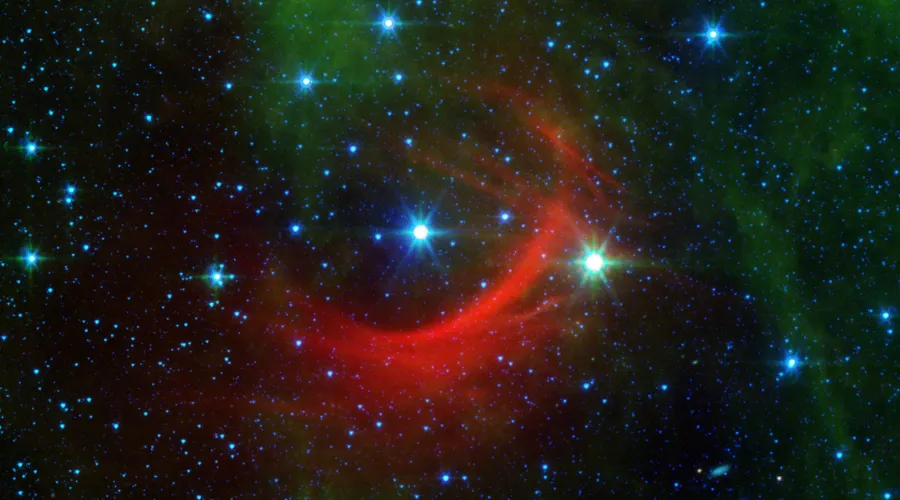What Are Blue Supergiant Stars and Why Are They So Mysterious?

Few cosmic phenomena captivate astronomers like the enigmatic blue supergiant, a stellar titan that burns bright, lives fast, and dies explosively.
Anúncios
These rare, luminous giants defy expectations, challenging our understanding of stellar evolution.
But what makes them so unique, and why do they remain shrouded in mystery?
Their existence forces scientists to reevaluate long-held theories about star formation and life cycles.
As we explore these celestial giants, we uncover layers of complexity that reveal the intricacies of the universe.
The study of blue supergiants not only enhances our knowledge of stellar life but also sheds light on the fundamental processes that govern cosmic evolution.
Defying the Stellar Norms
Unlike their smaller, more stable counterparts, blue supergiants are massive, volatile, and short-lived.
Born with at least 10 times the Sun’s mass, they blaze at scorching temperatures above 20,000°C, emitting an intense blue-white glow.
Their sheer luminosity—up to a million times brighter than the Sun—makes them visible across vast cosmic distances.
This visibility allows astronomers to study their properties even from billions of light-years away.
However, their brightness is a double-edged sword; it also makes them susceptible to rapid changes that can obscure their true nature.
Understanding these stars requires sophisticated techniques and instruments capable of capturing fleeting moments in their life cycles.
Yet, their brilliance comes at a cost.
These stars burn through their nuclear fuel at an astonishing rate, surviving only a few million years before meeting a dramatic end.
Compare that to our Sun, which will shine steadily for billions of years.
It’s like comparing a wildfire to a candle—one rages fiercely but briefly, while the other endures.
This ephemeral nature adds to the allure of blue supergiants, as they remind us of the transient beauty of the cosmos.
The Riddle of Their Short Lifespan
One of the biggest puzzles surrounding blue supergiants is their evolutionary path.
Theory suggests they should quickly transition into red supergiants as they age, yet many remain stubbornly blue.
A 2020 study published in The Astrophysical Journal found that some retain their blue hue due to intense stellar winds stripping away outer layers, altering their structure.
This phenomenon raises questions about the mechanisms that govern stellar evolution.
Are there unseen factors at play that influence their life cycles?
Understanding these processes could unlock new insights into the life and death of massive stars.
Take Rigel, the brightest star in Orion.
Despite being a textbook blue supergiant, it defies simple classification.
Is it evolving into a red supergiant, or will it skip that phase entirely?
The answer remains unclear, highlighting how much we still don’t know about these stellar anomalies.
As astronomers continue to investigate, they hope to uncover the secrets hidden within these luminous giants.
+ Ever Heard of a ‘Solar Particle Shower’? Discover This Cosmic Phenomenon
Table 1: Key Characteristics of Blue Supergiants
| Feature | Description |
|---|---|
| Mass | 10–50 times the Sun’s mass |
| Temperature | 20,000–50,000°C |
| Luminosity | Up to 1,000,000 times brighter than the Sun |
| Lifespan | A few million years (vs. Sun’s 10 billion) |
| Fate | Supernova or black hole formation |

Cosmic Laboratories for Extreme Physics
These stars aren’t just fascinating—they’re cosmic laboratories.
Their extreme conditions allow astronomers to test theories about stellar winds, nuclear fusion, and even gravitational waves.
When a blue supergiant collapses, it can trigger a supernova so powerful it outshines entire galaxies.
Such events provide critical data for understanding the universe’s fundamental laws.
For example, Supernova 1987A—the closest observed supernova in centuries—originated from a blue supergiant in the Large Magellanic Cloud.
Its explosion provided unprecedented data, reshaping our models of stellar death.
Could future observations of similar stars unlock secrets about dark matter or neutron stars?
The potential is staggering.
As we gather more data, we may find connections between these explosive events and the formation of various cosmic structures.
Understanding blue supergiants could also lead to breakthroughs in our comprehension of the universe’s expansion and the forces driving it.
The Curious Case of Hypergiants
Some blue supergiants push limits even further, evolving into hypergiants like Eta Carinae—a behemoth with 100 solar masses, prone to violent eruptions.
In the 1840s, it ejected enough material to form ten Suns, briefly becoming the second-brightest star in the sky.
Today, it’s a ticking time bomb, expected to detonate as a hypernova within the next million years.
The study of hypergiants like Eta Carinae offers insights into the upper limits of stellar mass and the processes that govern their evolution.
These stars challenge existing theories, prompting scientists to rethink what we know about stellar life cycles.
The potential for a hypernova event raises questions about its impact on surrounding cosmic environments.
++ How to Find and Identify Orion’s Belt in the Night Sky
Table 2: Notable Blue Supergiants and Their Properties
| Star | Constellation | Mass (Solar Masses) | Distance (Light-Years) | Notable Feature |
|---|---|---|---|---|
| Rigel | Orion | ~21 | 860 | 7th brightest star in the night sky |
| Deneb | Cygnus | ~19 | 2,600 | One of the most luminous stars known |
| Eta Carinae | Carina | ~100 | 7,500 | Hypergiant with violent eruptions |

Why Haven’t We Solved Their Mysteries?
Despite advanced telescopes like Hubble and JWST, blue supergiants remain elusive.
Their rarity and short lifespans make them hard to study.
Only about 1 in 10,000 stars fits this category, meaning even our galaxy may host fewer than 100 at any given time.
This scarcity poses significant challenges for astronomers attempting to gather comprehensive data.
Moreover, their turbulent atmospheres create unpredictable behavior.
Magnetic fields, rotation speeds, and mass loss rates vary wildly, making each one a unique case study.
How do we decode a star that refuses to follow the rules?
The complexity of these stars necessitates innovative observational strategies.
As technology advances, astronomers hope to develop new methods to capture the fleeting moments of these stellar giants.
For those interested in the latest findings on blue supergiants, resources like NASA’s Astrophysics Data System provide valuable insights and research articles.
The Future of Blue Supergiant Research
Upcoming missions like the Vera C. Rubin Observatory and the European Extremely Large Telescope (ELT) promise breakthroughs.
By analyzing their light spectra in unprecedented detail, we may finally unravel why these stars resist classification.
One thing is certain: blue supergiants are more than just celestial oddities.
They’re key to understanding the universe’s most violent and beautiful events.
As we peer deeper into the cosmos, their secrets may illuminate the very nature of existence.
The ongoing research into these stars will likely yield discoveries that reshape our understanding of stellar physics.
So, the next time you gaze at Rigel’s piercing glow, remember—you’re looking at a cosmic rebel, a star that defies the ordinary.
And perhaps, in its defiance, lies the answer to our biggest astronomical questions.
